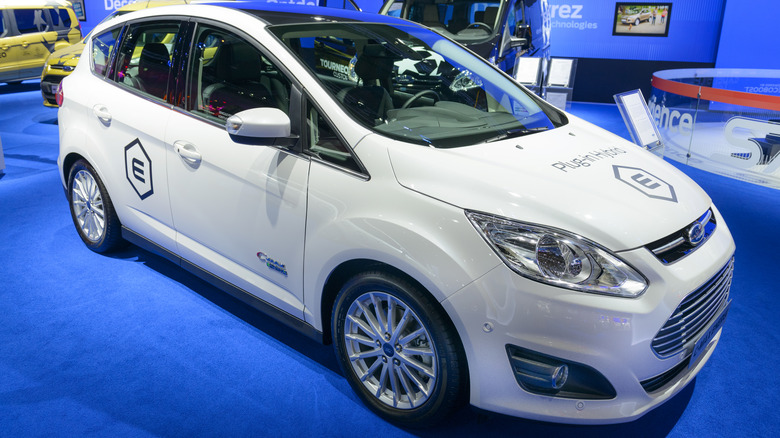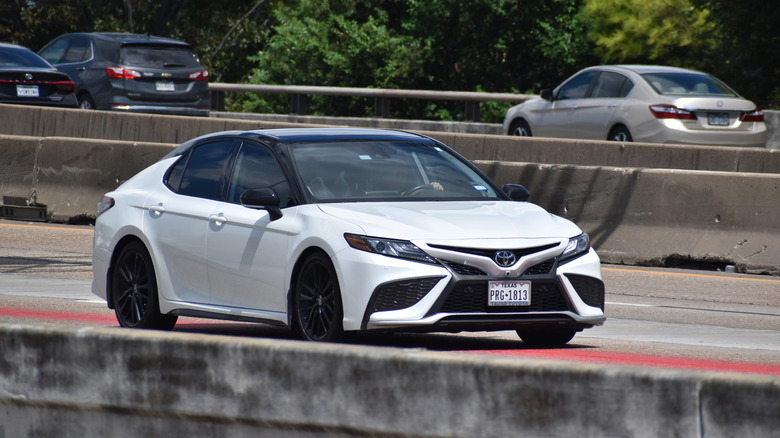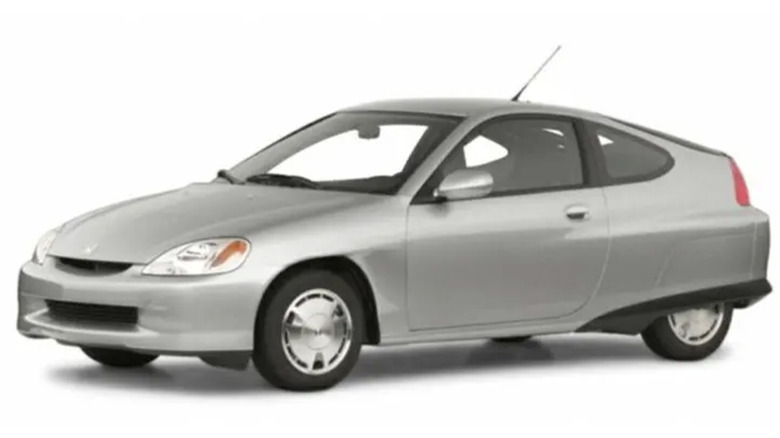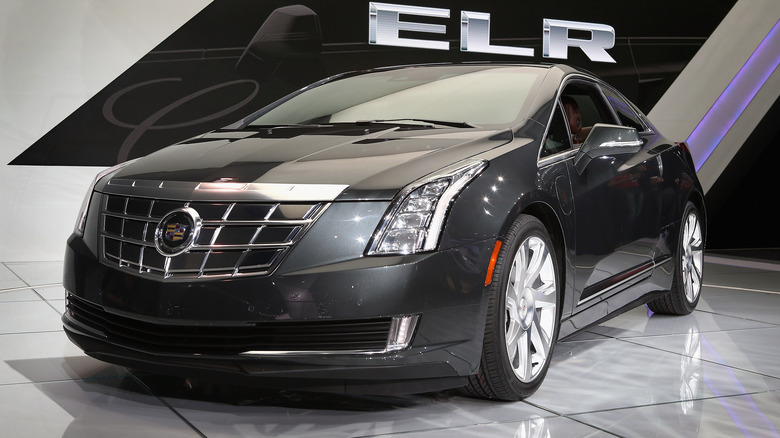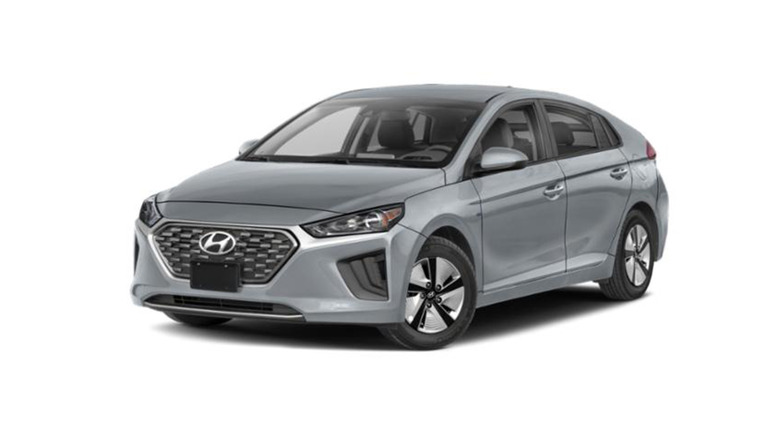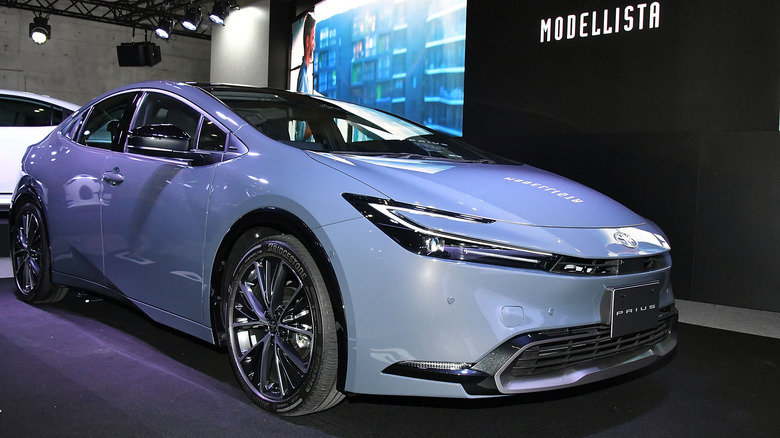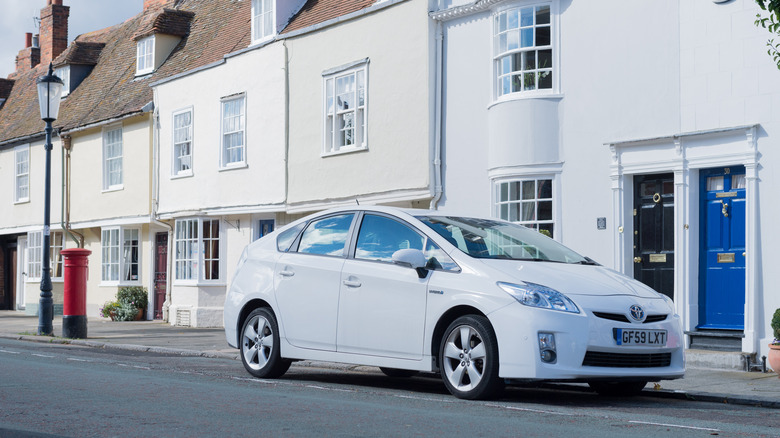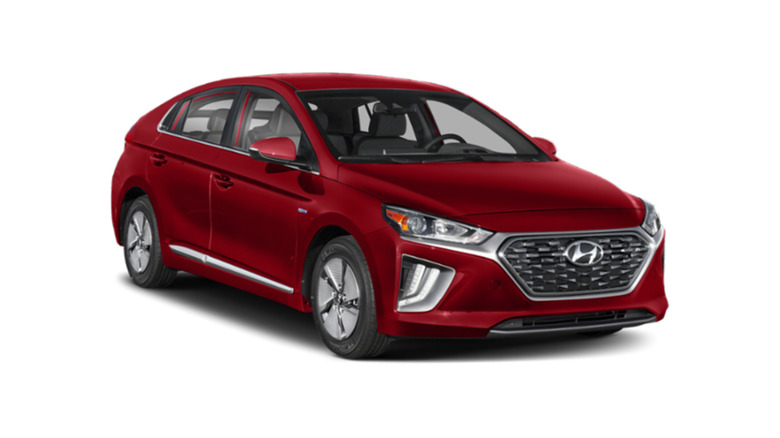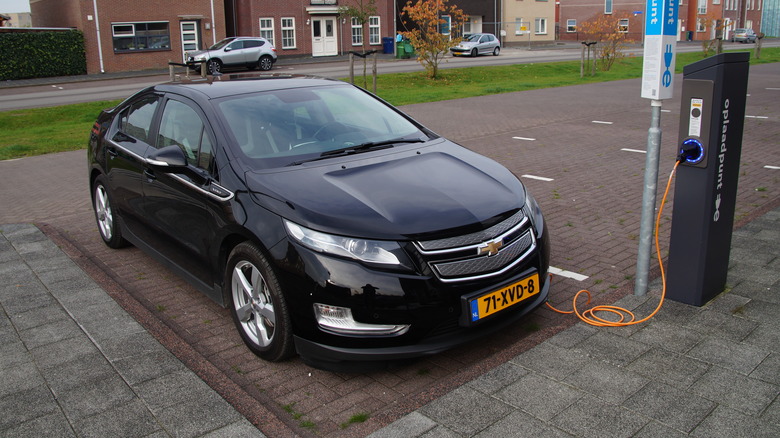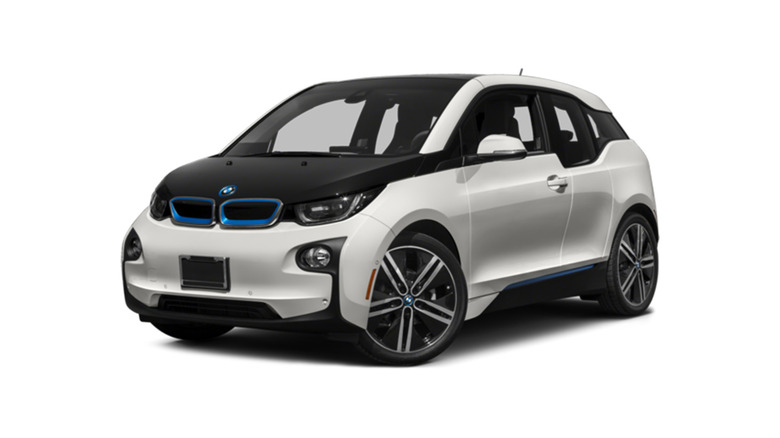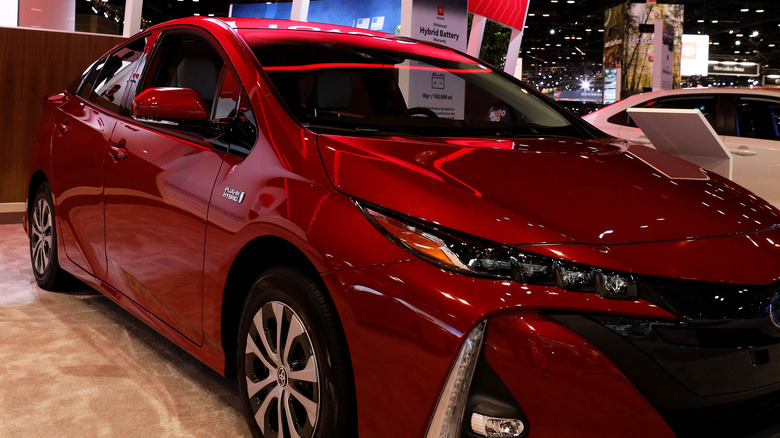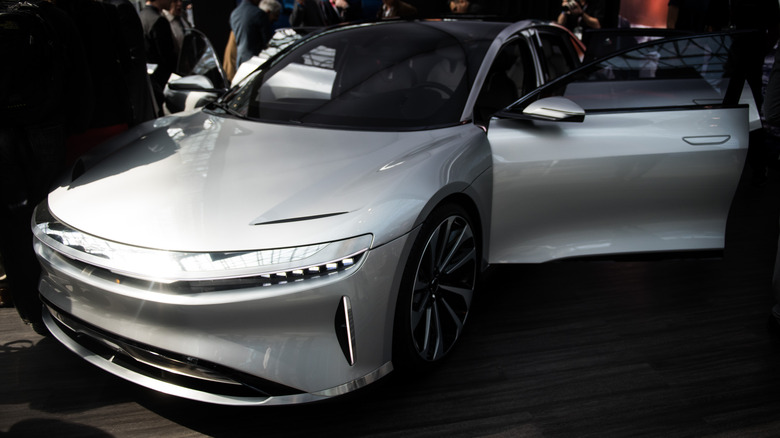12 Of Most Fuel-Efficient Cars Ever Made, Ranked
In general, vehicles are getting more fuel efficient. We're well into an era where automakers are adding turbo-charged four-poppers into SUVs for the fuel economy benefits. There are still a few examples of the V8 monster tank that gets almost single-digit fuel economy numbers, but they are a lot rarer than they used to be. Some OEMs, such as Nissan, are even using three-cylinder engines now just for that extra bit of fuel economy. Finding crossover SUVs that get north of 30 MPG isn't rare anymore.
Even now, more fuel-efficient tech is making its way into cars. Hybrid vehicles are taking things to the next level, easily getting cars up into the 40 or even 50 MPG range now. Long gone are the days when folks got made fun of for driving a Prius. With all of this advanced tech and the explosion of full-blown EVs, MPG numbers have gotten totally out of control in a good way. Let's talk about the most fuel-efficient cars that we could find.
For reference, we are going to mention EVs on this list even though they don't actually use gas. For that section, we'll be referring to their fuel economy as MPGe or miles-per-gallon equivalent. This is calculated by measuring how many miles an EV can go with 33.7 kWh of electricity. Thus, if you see that a car goes 120 MPGe, that means it travels 120 miles per 33.7 kWh of energy.
12. 2013-2015 Ford C-Max Energi / 2013-2015 Ford Fusion Energi
A good place to start is the 2013 through 2015 Ford C-Max Energi and the Ford Fusion Energi. Both cars featured a plug-in hybrid system in conjunction with their highly fuel-efficient engines. The Ford Fusion Energi was capable of getting 88 MPGe when on battery and 38 MPG combined when on gas. The C-Max Energi Plug-in Hybrid achieved identical numbers. Real-world estimates are higher or lower depending on a variety of variables, but we found estimates of about 51 MPG combined for both cars.
The plug-in variants have the cheat code of being able to travel a sizable distance without using any gas at all, which is something we'll see a few times on this list. Both cars offered 550 total miles of range, with roughly 20 miles of that being on electricity only. Since both cars use the same powerplants, that's how they were able to achieve identical fuel efficiency. Once the model year switched over, both cars became less fuel-efficient.
Unfortunately, Ford doesn't make either of these vehicles anymore. The C-Max was discontinued in 2019, while the Ford Fusion followed in 2020. It was part of Ford's change in direction to focus solely on SUV and truck offerings, with the Mustang being the sole survivor. Ford had some excellent options in its lineup, and it's a shame that no more of these hyper-efficient cars are in production anymore.
11. 2022 Honda Insight / 2024 Toyota Camry Hybrid
Toyota and Honda are rivals of sorts, especially in the sedan market. However, it's not the Accord versus the Camry like we usually see. This time, the Honda Insight is taking on the competitor. The 2022 Honda Insight and the 2023–24 Toyota Camry Hybrid have nearly identical fuel economy. Both vehicles boast a 52 MPG combined. The Toyota Camry Hybrid claims 51 MPG in the city and 53 MPG on the highway, while the Honda Insight does 55 MPG in the city and 49 MPG on the highway.
For the Honda Insight, unfortunately, Honda discontinued the car starting in the 2023 model year. However, the Accord still rules the roost in terms of popularity for the automaker. Reviewers praised the Insight for its superior fuel economy, good interior, and decent ride quality. However, with almost the entire Honda lineup getting electrification, having a dedicated hybrid sedan simply didn't make sense. The Accord and Civic both have hybrid variants now to carry the torch.
The Toyota Camry, on the other hand, is a very popular car, and its hybrid version is solidly built. Toyota has an excellent reputation for reliability, and the Toyota Camry is often near the top of the reliability rankings. The 2023–24 Camry is no different, and it's about as good as a car gets these days with a nice interior, good driving manners, and, of course, its outstanding fuel efficiency. There's no way a Camry Hybrid wasn't making it on this list.
10. 2000 Honda Insight
Before it went toe-to-toe with the Toyota Camry, the Honda Insight was in a class all its own. The 2000 Honda Insight was good for 49 MPG in the city and an astounding 61 MPG on the highway, with a total of 53 MPG combined. That made it one of the most fuel-efficient cars of its era. In fact, it was the first gas-electric hybrid car to ever be sold in the U.S., although the Toyota Prius existed in Japan before then.
The car was okay overall. It had a 1.0-liter, three-cylinder engine coupled with an electric motor to help it get around. It made it from 0 MPH to 60 MPH in about 10.5 seconds, which is a leisurely pace but not unusable, even for its era. Once up to highway speeds, it was capable of cruising for what felt like forever since it sipped gas with the utmost reluctance at those speeds. The rear wheel being partially hidden gave it a futuristic look for its era, but otherwise, it looked just like a normal car.
As we stated earlier, Honda produced Insight until 2019. After that, the Honda Civic and Honda Accord took over the mantle of bringing hybrid powertrains in car format. Since the Insight was based on the Civic at the end of its product life, it made more sense to just sell a Honda Civic Hybrid. Thus, you can still technically buy this car; it's just not called an Insight anymore.
9. 2014–2015 Cadillac ELR
The 2014 and 2015 Cadillac ELR is one of Cadillac's first plug-in hybrid vehicles. The plug-in hybrid boasts 82 MPGe when on its battery power and 33 MPG combined when on gas power. In hybrid mode, though, it boasted 54 MPG in the city, 55 MPG on the highway, and 54.5 MPG combined. Cadillac only sold 1,310 of these cars in 2014 and 1,024 of them in 2015. Despite it being a market failure, it was one of Cadillac's most fuel-efficient cars.
For the most part, the car is pretty decent overall. It was priced twice as high as GM's other offering, the Chevy Volt. The engine on the ELR put out 157 HP with 295 pound-feet of torque when you include both the gas and electric engine. It also had decent styling and a nice interior, and it was reasonably comfortable to drive. It was one of the few hybrids from its era that looked like a normal car, and Cadillac makes good-looking cars in general.
Unfortunately, the Cadillac ELR was canceled following the 2016 model year. For the most part, its $73,000 asking price for a front-wheel drive plug-in hybrid was the primary reason, especially when GM was selling the same car for half that price under the Chevy branding. People simply weren't interested in the car. It was the right product at the wrong time and for the wrong price. Now that EVs are in, Cadillac may consider bringing back the nameplate.
8. 2022 Hyundai Ioniq
The 2022 Hyundai Ioniq is a hybrid vehicle. It's largely overshadowed by the Ioniq 5 and Ioniq 6, which are full EV models since EVs are red hot right now. However, the regular Ioniq actually gets pretty good gas mileage. Most trims achieve 54 MPG in the city and 57 MPG on the highway for a combined value of 55 MPG. The Blue trim bumps up to 59 MPG. Meanwhile, the plug-in hybrid can do 119 MPGe on battery power and 52 MPG combined on gas power. In short, it's quite a fuel-efficient machine.
As a whole, the Ioniq is pretty good. It's not the fastest car on the planet, but it'll get you to highway speeds and stay there without too much trouble. Passing cars, on the other hand, might take you a second. Most of the car is reasonable, with a decent interior, ride quality, and tech. However, it's pretty clear that even Hyundai wanted to skim over this and get to the Ioniq 5 and 6 with their vastly more expensive and advanced technology. That's a shame, too, because the Ioniq Blue variant has a rated range of 700 miles, which is impressive.
Unfortunately, the 2022 Hyundai Ioniq was also the model's swan song. Hyundai discontinued it before the 2023 model year. The nameplate will live on with the EV versions of the car. Even so, it's not easy to find cars that can do mid to high-50 MPG ratings, and the Ioniq was one of them.
7. 2022–23 Toyota Prius
The Toyota Prius is a shoo-in for this list, and fortunately, it's for the more modern versions of the car. The 2022 through 2024 models are highly fuel efficient. The 2022 model boasts 58 MPG in the city, 53 MPG on the highway, and 56 MPG combined. The 2023 and 2024 models improve those numbers marginally with 57 MPG in the city, 56 MPG on the highway, and a combined 57 MPG. There is a plug-in version, the Toyota Prius Prime, that does even better, but we'll get to that later.
In terms of performance, the Prius has improved a lot over the older, less exciting models. Not only do they look a lot nicer now, but the engines are also more powerful. Newer Prius cars can go zero to 60 in 7.7 seconds, which is a dramatic improvement from the car's earlier days. Reviewers praised the car for being comfortable and tech-focused, although it can get a little loud on the freeway. With the major facelift, you'd be hard pressed to find a more agreeable sedan that also pulls north of 50 MPG.
This won't be the only time we talk about the Prius on this list, but this is an excellent start for Toyota. The company has been doing hybrids longer than most automakers, so they know a thing or two about the craft. It's encouraging to see Toyota bring that success to modern vehicles while also making something that looks good and drives well.
6. 2012–2015 Toyota Prius Plug-in
Well, you were warned. Here is another Prius. This time, we're talking about the plug-in hybrid version from the 2012 through 2015 model years. Much like the other plug-in hybrids on this list, they get impressive fuel economy with or without their batteries. For the Prius, that means 95 MPGe on the electric battery while also doing 50 MPG combined on fuel. That averages out to about 57.5 MPG. That's a bit better than the regular hybrid version, which did 48 MPG combined.
This was built back before hybrids needed to look cool. That means it had that polarizing egg shape and slower but vastly more efficient engines. This thing went zero to 60 MPH in 9.9 seconds, which is a fairly leisurely pace. It was otherwise a solid, roomy, and comfortable car. It just wasn't as fun to drive. This was fairly indicative of fuel-efficient cars back then. You were there to get good fuel economy, not tear up the streets. Things are different now, as we see in the newer Prius models.
The third generation of the Prius was indeed one of the most fuel-efficient that's ever existed. There are five generations now, and none of them do as well as the third generation in fuel economy, at least when compared to the plug-in hybrid. That said, the 2024 Prius Prime does 54 MPG on just the gas engine and 133 MPGe with the battery, so technically, it's even more fuel efficient.
5. 2020 Hyundai Ioniq Blue
The Hyundai Ioniq returns to the list with the 2020 edition, specifically the Blue trim. That specific trim of this vehicle was capable of 57 MPG in the city, 59 MPG on the highway, and 58 MPG combined. The other trims could do 55 MPG combined, while the plug-in hybrid had the benefit of 133 MPGe on their electric motors. It's odd because there weren't that many differences between the Blue trim and the SEL trim of the car. In the real world, drivers struggle to hit the EPA estimates with either trim.
There doesn't seem to be much of a reason for the difference. There are some theories that the EPA classifies it differently because it's a specific weight class, but it's possible to get the same fuel efficiency numbers with higher trims. Other than that, this Ioniq was just as nice as the 2022 model listed above. It had below-average speed for its class, which was still fairly typical of a hybrid in 2020. Otherwise, there wasn't much wrong with it.
At 58 MPG, the 2020 Ioniq could cruise for a long time between fill-ups. Oddly, the 2020 model was one of the least popular versions of the car when you subtract the truncated 2022 model year when the car was discontinued. If you stumble upon one of these, it's a calm drive, but you'll get great bang for your buck at the pump.
4. 2013–2015 Chevrolet Volt
On paper, the Chevy Volt wouldn't seem like it would make a list like this. The car was capable of 98 MPGe on its battery power and 37 MPG combined on the gas engine. However, real-world driving puts this car at an incredible 73 MPG when averaged out with both the electric and gas engines. Some drivers even report getting over 100 MPG, mostly if they drive short distances where the gas engine rarely has to kick in. That's quite impressive.
The Chevy Volt is one of the reasons nobody bought the Cadillac ELR. The two were built on the same platform and used mostly the same powertrain. However, the ELR's $70,000 price tag couldn't compete with the $34,000 price tag of a brand-new Chevy Volt from back then. The Volt was small, quicker than many hybrids in its day, and it looked like a normal car. Even its zero to 60 time was nine seconds flat, which was almost a second faster than the Prius back then.
Chevy ultimately discontinued the Volt in 2019. The reason was the same as the Hyundai Ioniq, the Honda Insight, and others. Chevy was simply adding more electrification to its other vehicles, so it didn't need a dedicated car for it. Plus, people are much more into SUVs these days, so a lot of automakers are reducing the number of sedans they make. The Volt was a victim of that mentality, and it will be missed.
3. 2014–2015 BMW i3 REx
The BMW i3 REx is an odd case. It's a plug-in hybrid with decent numbers on paper. It's rated to do 117 MPGe on the electric engine and 39 MPG combined on the gas engine. The thing is, people had a lot of fun with this one because it was capable of doing up to 70 miles on electricity alone, which is a lot more than most plug-in hybrids from any era. Thus, people were able to goose the gas mileage by virtually never driving for long enough to need to use the ICE engine. The result was an average of 112 MPG in real-world usage. One individual even reportedly averaged 1,892 MPG, going almost 10,000 miles between fill-ups.
The 70-mile range on the electric motor allowed for such high fuel economy. You can do almost anything in 70 miles unless your commute is unusually long or you are going on road trips. That gave owners plenty of opportunities to recharge the battery before needing to hit the fuel pump. That's why this is one of the most fuel-efficient cars ever. Even now, the all-electric range rarely sneaks above 40 miles.
The car itself was also pretty nice. It was roomy enough for four adult passengers with quick acceleration and good handling, as is the norm for BMWs. Only the REx, or Range Extender version of the car, was capable of all that range. The rest were pretty average for hybrids back then.
2. Almost all plug-in hybrids
We listed several plug-in hybrids in the list above, but there are a lot more than there used to be, and they're starting to do some crazy fuel efficiency numbers. Some examples include the Hyundai Tucson PHEV, which can do 33 all-electric miles. Much like the BMW above, that's enough to commute, go grocery shopping, and do just about everything outside of road trips. The 2023 Volvo S90 PHEV can do 38 miles, while its V60 stablemate can do 41. Most modern plug-in hybrids have a similar range.
The point is, it's not unusual to find plug-in hybrids capable of performing a full day's worth of driving without any gas. The average commute for Americans was 16 miles back in 2021. That means any PHEV with 32 all-electric miles or better can get the average American to and from work without using an ounce of gas, especially if their job has an EV charger nearby. That gives almost all modern PHEVs similar fuel economy numbers to EVs, and that's more than all the cars on this list except the BMW i3 REx.
Thus, we omitted a great deal of plug-in hybrids from the list and decided to talk about them en masse here. If you get a plug-in hybrid with a reasonable amount of all-electric miles, you might have to drive the car without the battery charged on purpose just so the gas doesn't sit in your gas tank for too long. That's not a bad position to be in.
1. EVs
EVs are the king of fuel efficiency. If you go to fueleconomy.org and sort all vehicles from all years by their fuel economy, you'll be met with a long list of EVs. The Tesla Model 3 has 142 MPGe, the Lucid Air has 140 MPGe, the Hyundai Ioniq 6 ties it with 140 MPGe, and the BMW i3 BEV, the full EV version of the i3, does 124 MPGe. If this list were written without these kinds of considerations, the entire thing would be EVs. There are more than 12 of them, and they all do better than any hybrid or plug-in hybrid on the market.
What's nice about EVs is that they're insanely fuel efficient, at least when using the MPGe rating to compare them to ICE engines. However, unlike hybrids or even plug-in hybrids, EVs are also fun to drive. Most of them have excellent acceleration and handling metrics with tons of high-end tech and other modern features. Of course, they also cost an arm and a leg, so it's to be expected.
In short, if you want to see the most truly fuel-efficient cars, just go find a list of available EVs. Virtually all of them are rated for north of 100 MPGe and don't have less efficient gas engines to drag them down. This is the pinnacle of fuel efficiency for now, and there is no doubt about it.

